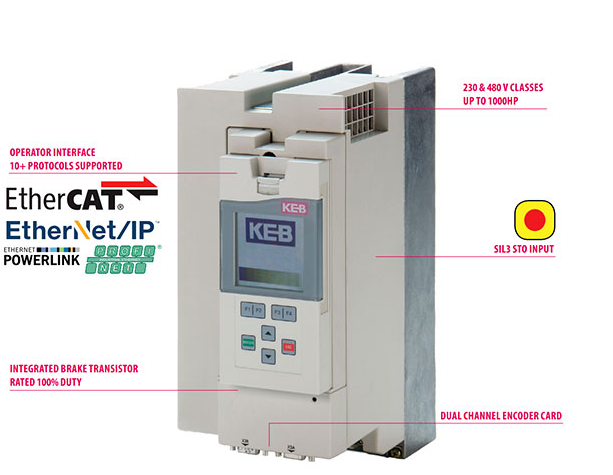Posted on 25th Oct 2023

Variable Speed Drives (VSDs) such as KEB F5 Drive OR KEB F5 can save energy expenses when used to operate an AC motor in an application where the motor does not need to run at maximum speed. Variable speed drives, sometimes referred to as variable frequency drives, let you adjust the motor-driven equipment's speed to fit the needs of the process.
Constant torque and variable torque drives are the two main categories into which variable speed drives and the loads they are applied to fall. Applications with variable torque have a far higher potential for energy savings than those with constant torque. Most HVAC applications use centrifugal pumps and fans, which are examples of variable torque loads. Machine tools, punch presses, rock crushers, vibrating conveyors, and other applications where the drive maintains a constant V/Hz ratio are examples of loads with constant torque.
In applications requiring variable torque, the horsepower needed changes roughly with the cube of the speed, and the torque required varies roughly with the square of the speed. This means that even a slight decrease in speed results in a significant reduction in horsepower. In a variable torque application, the energy consumption of a motor at 50% speed is just 25% of that at 100% speed. These are known as the Affinity Laws, and they establish the connections among horsepower, torque, flow, and speed.
Variable Speed Drives (VSDs): In HVAC applications, where load needs are often lower than maximum speed, VSDs such as KEB F5 Drive OR KEB F5 available at CM Industry Supply Automation enable you to use less energy than alternative speed control systems.
Variable speed drives are superior to other AC motor control methods in terms of precise process control. Soft starts and reduced voltage soft starters can only gently ramp the motor up to full speed and back down to shutdown; full-voltage (across the line) starters can only run the motor at full speed. On the other hand, variable speed drives have the ability to be programmed to deliver a certain amount of torque, stop at a specified location, or operate the motor at a specific speed.
When it comes to speed precision and quick torque response, contemporary AC variable speed drives actually resemble DC drives a great deal. However, AC motors are significantly more common than DC motors since they are far more inexpensive and reliable.
The majority of drives used in the field have open-loop functioning since they use Volts/Hertz type control. Although these drives are adequate for most Variable Speed Drive applications, they cannot retrieve input from the process. Slip compensation, on the other hand, allows a lot of open-loop variable speed drives to detect their output current and calculate the difference between their real speed and the setpoint (the preset input value). Based on this estimate, the drive will then automatically ajust itself towards the setpoint.
For fan and pump applications, the majority of variable torque drives feature PID capability. This enables the drive to maintain the setpoint based on real process feedback rather than a guess. Process variables including liquid level, air flow rate, liquid flow rate, and pressure levels are detected using a transducer or transmitter. Subsequently, the signal is transmitted to a PLC, which relays the process feedback to the drive. This ongoing feedback is used by the variable Speed Drive to self-correct and maintain the setpoint.
Drives with closed-loop operation can also reach high levels of accuracy for other applications. A sensorless vector drive or a field-oriented vector drive can be used for closed-loop operations. An encoder, which monitors and transmits to the drive the speed and/or rate of the process, such as a conveyor, machine tool, or extruder, provides process feedback to the field-oriented vector drive. In order to maintain the specified speed, rate, torque, and/or position, the drive then modifies itself appropriately.
Motors started with single-speed starting techniques experience excessive torque at startup and current spikes up to ten times the full-load current. In contrast, variable speed drives increase the motor's speed gradually to minimize mechanical and electrical strain, lower maintenance and repair costs, and prolong the life of the driven equipment and the motor.
The locked rotor (zero speed) is approximately 600% of the full-load flowing current at the moment of energization. The motor then accelerates to its maximum speed as the heavy current gradually decreases as the load releases, but not before creating an unacceptably large voltage sag on the power system that negatively impacts other loads. Additionally, it may result in shock damage and excessive long-term motor wear. Since across-the-line starting introduces issues upstream into the utility's system, causing issues for other customers, using this beginning technique may lead the utility to set a limit on the amount of motors you can use. The motor insulation is stressed by the sudden starts and stops that occur during switching surges.